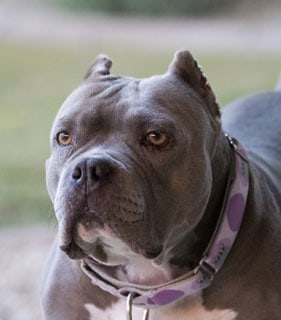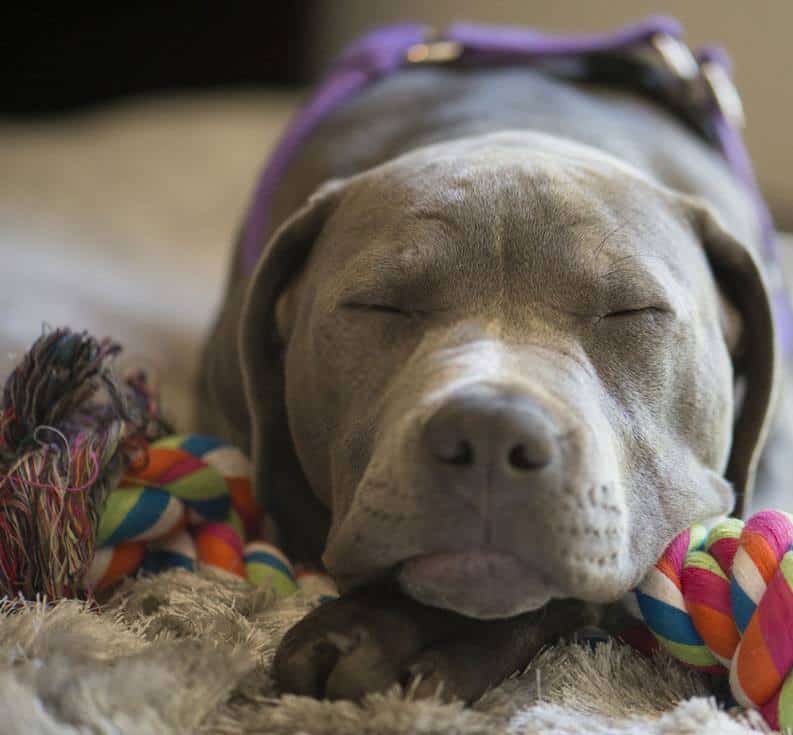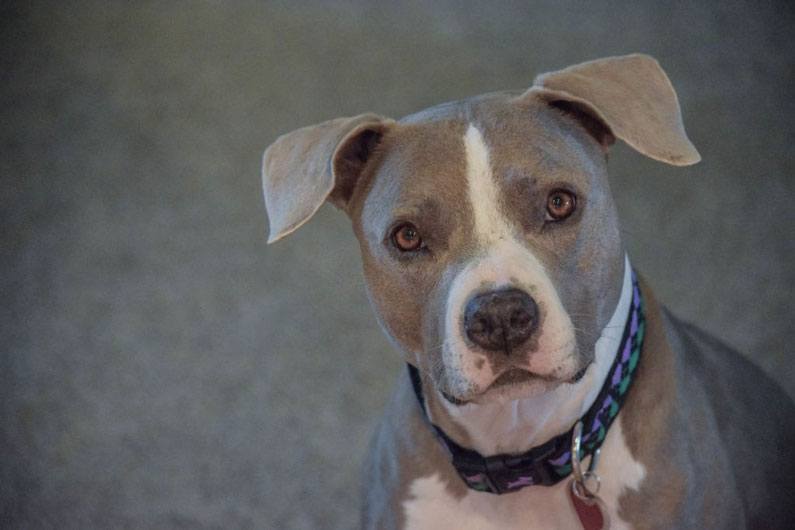Last Updated on 11/05/2020 by Veronica Jones
Blue Nose Pitbull; if the name isn’t enough to spark your interest then maybe the breed’s personality misconceptions, sometimes goofy expressions, and strong loyalty will. The Blue Nose Pitbull isn’t a breed in itself, but a color variation in the popular pitbull group.
Why the Name Blue Nose Pitbull?
This almost goes without saying. A Blue Nose Pitbull has a grey-blue color to the coat, skin around its eyes, toenails, and of course nose. This is in contrast to the normal black nose of most pitbulls. While not the blue color of the sky, it is a grey-blue tone that some of you may be familiar with if you’ve seen a Russian Blue cat. Another note about the name, pitbull is sort of an umbrella term that can be used to describe one of several different breeds. The most common are the American Pitbull Terrier, the American Staffordshire Terrier, and the Staffordshire Bull Terrier. These three breeds all have similar origins and were originally bred to bait bulls.
How Do Blue Nose Pitbulls Get the Blue Color?
The grey-blue color common to Blue Nose Pitbulls is actually due to a genetically recessive color trait that causes a decrease in the melanin production in the skin. Melanin is responsible for the pigment in skin, so more melanin=black nose, less melanin=blue nose. Being caused by a recessive trait means that Blue Nose Pitbulls are extremely rare. If you think way back to your life sciences classes you may remember Mendelian genetics with dominant and recessive genes. In order for a recessive gene to be expressed, both parents must possess it. Even then there’s only a one in four chance that a puppy from these parents will be a Blue Nose.
 As you can imagine having a Blue Nose Pitbull can be a big deal. Not only are they rare, but they are also nice to look at. Their grey-blue coat and nose can be a real conversation piece. Because of this some breeders are actively trying to breed for the recessive gene. Since Blue Nose Pitbulls are so rare, the gene pool is pretty limited. This can lead to lots of inbreeding in hopes of increasing the chances for a Blue Nose Pitbull. While most negative affects of inbreeding, such as cancer, immune disorders, and heart disease, aren’t expressed until later in puppyhood or not even until the dog is an adult, it’s hard to tell if the puppy you’re getting is going to have issues.
As you can imagine having a Blue Nose Pitbull can be a big deal. Not only are they rare, but they are also nice to look at. Their grey-blue coat and nose can be a real conversation piece. Because of this some breeders are actively trying to breed for the recessive gene. Since Blue Nose Pitbulls are so rare, the gene pool is pretty limited. This can lead to lots of inbreeding in hopes of increasing the chances for a Blue Nose Pitbull. While most negative affects of inbreeding, such as cancer, immune disorders, and heart disease, aren’t expressed until later in puppyhood or not even until the dog is an adult, it’s hard to tell if the puppy you’re getting is going to have issues.
Also, since some breeders of Blue Nose Pitbulls are only concerned about the color, they forget to breed for the most important pitbull trait: a friendly personality. If you’re thinking about bringing home a Blue Nose Pitbull either make sure you get your puppy from a reputable breeder with a proven track record or adopt an adult with a proven temperament and who has passed their health checkup.
What Are Blue Nose Pitbulls Like As Pets?
It’s important to remember that pitbulls were originally bred to be aggressive. Their broad head and muscular body made them the top choice for bull and bear-baiting. Pitbulls have also been used to hunt wild boars and in dog fighting. They were later used as guard dogs and then eventually became family pets. Thankfully most of these blood sports are not illegal in the United States but some of the stigma surrounding pitbulls as pets still remains. Several cities and towns have tried to make ordinances against having pitbulls as pets due to the belief that they are all aggressive. It’s also not uncommon for rental properties to not allow renters to keep pitbulls. Blue Nose Pitbulls are members of this breed and therefore share the same history and stigma. There is some belief that irresponsible breeding the color has lead to an increase in bad temperament among Blue Nose Pitbulls.
All that being said, Blue Nose Pitbulls can make great pets. Energetic, loyal, sensitive, and social, Blue Nose Pitbulls can fit well into a family setting. Even though they can look intimidating, these dogs are very kind if treated appropriately. They do better with an active family and a large area to roam. If they aren’t allotted the proper amount of exercise, Blue Nose Pitbulls may turn their energy elsewhere and become aggressive. They also have a tendency to become overweight if not given the proper amount of exercise.
How Do You Train a Blue Nose Pitbull?
This breed can be stubborn, or bull headed if you will, which can make training a little more difficult. This just means that you need to make sure that you are consistent and use lots of positive reinforcement. Blue Nose Pitbulls need to know that you are in charge. If you don’t express your dominance early on, they will try to become the alpha in the family. To express dominance you just need to be firm with what you are asking and not let them push you around. You give the order, not the other way around.
Socialization is very important for Blue Nose Pitbulls and the earlier the better. If you get one as a puppy, it’s important to introduce them to smaller animals that they may encounter later in life when they are much larger. This will hopefully make this smaller animal less play-toy like when they are bigger. Socialization with children and other dogs is invaluable when it comes to training Blue Nose Pitbulls. Both children and other dogs can be great companions for these dogs if they are shown how to appropriately behave around them at an early age.
Don’t allow your Blue Nose Pitbull to lunge or jump at people, even in a playful manner.
Both of these gestures can be taken as signs of aggression for someone that isn’t familiar to your pet. Given the breed’s history, some people can be too soon to jump to conclusions when confronted with this type of behavior from a Blue Nose Pitbull.
If you don’t get a Blue Nose Pitbull as a puppy, don’t worry. You can still train most adult dogs to be loving and respectful members of your family. Just start as soon as you take them home and be consistent with what you are asking. Never use negative reinforcement with them and be on the lookout for any even subtle signs of aggression.
How Do You Care For a Blue Nose Pitbull?

All members of the pitbull breed have considerable muscle mass compared to other dogs. In order to adequately nourish that muscle, they need a diet that is high in protein. Choose a dog food that is of high quality with meat as the first ingredient. A lot of Blue Nose Pitbull owners may choose to feed a raw diet to their pets. Before feeding a raw diet check with your veterinarian to make sure you are providing properly balanced nutrition. Keep in mind that Blue Nose Pitbulls are a medium to large breed that can be as big as 70 pounds and live up to 15 years, so they will require a lot of food.
Grooming needs of a Blue Nose Pitbull are pretty much nonexistent. Their short grey-blue coat only needs the occasional brushing to remove loose hair and matting isn’t usually a problem. You should clean their ears periodically as well to prevent ear infections.
What Health Concerns Do Blue Nose Pitbulls Have?
Watch out for skin diseases with Blue Nose Pitbulls. They have a slightly higher propensity for issues like mange. Also, being a medium to large breed dog, Blue Nose Pitbulls may be subject to hip and elbow dysplasia. As stated before, Blue Nose Pitbulls can have a higher chance of being inbred in order to achieve that sought-after coat color. Inbreeding increases the chances of deafness, blindness, and bad temperament as well as the health concerns previously stated. To help prevent these health issues, make sure to use reputable breeders that perform pre-breeding testing and practice responsible breeding techniques. Be sure to provide quality high protein dog food and plenty of exercise daily.
Is A Blue Nose Pitbull The Right Dog For You?
Blue Nose Pitbulls are unquestionably attractive dogs and can be extremely sweet, loving and trustworthy. Before you decide to bring one home to your family remember that they require lots of regular exercise and attention, can be a bit more involved to train, and would prefer to be the only dog in the household. If you can’t provide all of these necessities, maybe this breed isn’t a good fit. If you believe that you can, you should next decide if you want a puppy or to try an adult. Keep in mind that puppies will be easier to socialize if you have children or other dogs but may take more work to train. Adult dogs may come with a higher chance of having a poor temperament. Just look at each dog as an individual to assess whether it will be a right fit for you.
If choosing a Blue Nose Pitbull puppy is the route you take, make sure to find a reputable breeder that comes with great references. Be aware that some breeders may try to take advantage of this unique color and charge upwards of $3,000. There is no need to pay that much. There are many breeders out there who are in it for the betterment of the breed and won’t charge you near that much. It’s definitely worth doing your research.
Being a member of the pitbull breed, Blue Nose Pitbulls can be terrific pets and lifelong friends to you and your family. It’s important to look past the temperament stigma that this breed has faced in the past. You will have to do your part to train and socialize them but you will be rewarded with a loyal companion.

